Marc Abrahams's Blog, page 294
November 28, 2015
The tweets of Dr. Kwak (Twitter Investigator)
 The tweets of , who is an expert on Twitter [being the lead author of ‘What is Twitter, a social network or a news media?’ (cited 3,000+ times)] may be found here.
The tweets of , who is an expert on Twitter [being the lead author of ‘What is Twitter, a social network or a news media?’ (cited 3,000+ times)] may be found here.

November 27, 2015
From tumbling toast to falling phones
The physicist who won an Ig Nobel Prize for analyzing whether buttered toast usually falls on the buttered side has now examined the similar question: what happens when you drop a mobile phone?
Why do phones always seem fall with their screen facing down? While most people would be satisfied with blaming their luck or Murphy’s Law (anything that can go wrong, will go wrong) when they drop their phone and crack the screen, Motorola has taken the problem very seriously. So seriously that they have asked physicist Robert Matthews to study the phenomenon. Matthews is best known for his paper called Tumbling toast, Murphy’s Law and the fundamental constants, which studied why toast always seems to land on the buttered side. For this paper, Matthews won an Ig Nobel prize in 1996.
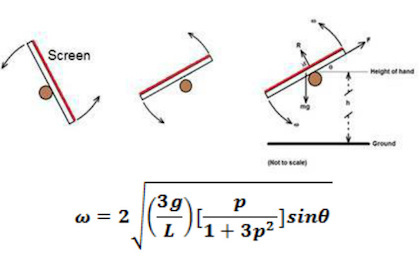
Here’s a minimovie documentary about the tumbling toast research:

Ig Nobel day-after-Thanksgiving broadcast on Science Friday
Spread the word, please! Today, Friday, November 27, the Science Friday radio program will broadcast its specially edited highlights from the 2015 Ig Nobel Prize ceremony. It’s SciFri’s 24th annual broadcast (SciFri began this day-after-Thanksgiving tradition in 1992, the Ig Nobel ceremony’s second year).
Listen to it on a public radio station, if you’re near one, or on the Internet. (Science Friday is broadcast as two separate, hour-long programs. The Ig Nobel broadcast comprises the entire SECOND HOUR of Science Friday. HOWEVER — Boston is going to be an exception; in Boston, WBUR (90.0 FM) broadcasts only one hour of the two-hour-long Science Friday program, and by special arrangement, today WBUR plans to broadcast the Ig Nobel ceremony special at 2:00 pm.)
This photo shows a moment at the ceremony: Justin Schmidt and Michael Smith, co-winners of the 2015 Ig Nobel Prize for physiology and entomology, finish their acceptance speech at the urging of eight-year-old Miss Sweetie Poo (who is assisted by many of the former Miss Sweetie Poos, who were on hand for a reunion at this, the 25th First Annual Ig Nobel Prize ceremony. Alexey Eliseev took the photo:
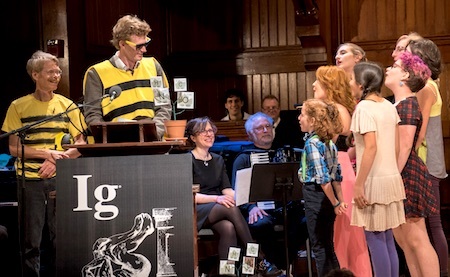
BONUS: Download your own copies of IgBill, the printed program for the 2014 ceremony, and the 2014 ceremony poster.
BONUS: From SciFri archives, here’s last year (2014)’s Ig Nobel broadcast.
BONUS: Subscribe to the magazine — the Annals of Improbable Research, and you will receive the special Ig Nobel issue, as well as five other improbable issues!

November 26, 2015
Cereal Killer
Murder aforethought be described in this study, which focuses on a particular kind of cereal killer—one that strikes from within:
“Programmed cell death in cereal aleurone,” Angelika Fath [pictured here], Paul Bethke, Jennifer Lonsdale, Roberto Meza-Romero and Russel Jones, Plant Molecular Biology, 2000 Oct;44(3):255-66. The authors, at the University of California, Berkeley, report:
“Progress in understanding programmed cell death (PCD) in the cereal aleurone is described. Cereal aleurone cells are specialized endosperm cells that function to synthesize and secrete hydrolytic enzymes that break down reserves in the starchy endosperm. Unlike the cells of the starchy endosperm, aleurone cells are viable in mature grain but undergo PCD when germination is triggered or when isolated aleurone layers or protoplasts are incubated in gibberellic acid (GA).
Abscisic acid (ABA) slows down the process of aleurone cell death and isolated aleurone protoplasts can be kept alive in media containing ABA for up to 6 months. Cell death in barley aleurone occurs only after cells become highly vacuolated and is manifested in an abrupt loss of plasma membrane integrity. Aleurone cell death does not follow the apoptotic pathway found in many animal cells. The hallmarks of apoptosis, including internucleosomal DNA cleavage, plasma membrane and nuclear blebbing and formation of apoptotic bodies, are not observed in dying aleurone cells. PCD in barley aleurone cells is accompanied by the accumulation of a spectrum of nuclease and protease activities and the loss of organelles as a result of cellular autolysis.”

November 25, 2015
Podcast #39: A beef boom, and who can touch whom
A beef boom, the question of who can touch whom, and human-milk-smell perfume, for the benefit of babies — all of these turn up in this week’s Improbable Research podcast.
LISTEN TO IT! …or click on the “Venetian blinds” icon — at the lower right corner here — to select whichever week’s episode you want to hear:
SUBSCRIBE on Play.it, iTunes, or Spotify to get a new episode every week, free.
This week, Marc Abrahams tells about:
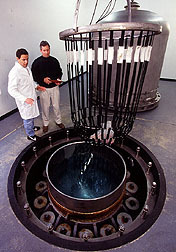 A beef boom.
(Lee, Jill (1998). ‘Hydrodyne Exploding Meat Tenderness.’ Agricultural Research (June): 8–10. / Godfrey, Charles S. (1970). ‘Apparatus for Tenderizing Food.’ US Patent no. 3,492,688, 3 February. Featuring dramatic readings by Daniel Rosenberg.) The photo here shows Morse Solomon and a colleague preparing to tenderize up to 600 pounds of meat by subjecting it to an explosion.
A beef boom.
(Lee, Jill (1998). ‘Hydrodyne Exploding Meat Tenderness.’ Agricultural Research (June): 8–10. / Godfrey, Charles S. (1970). ‘Apparatus for Tenderizing Food.’ US Patent no. 3,492,688, 3 February. Featuring dramatic readings by Daniel Rosenberg.) The photo here shows Morse Solomon and a colleague preparing to tenderize up to 600 pounds of meat by subjecting it to an explosion.Who can touch whom. (“Topography of social touching depends on emotional bonds between humans,” Juulia T. Suvilehto, Enrico Glerean, Robin I. M. Dunbar, Riitta Hari, and Lauri Nummenmaa, Proceedings of the National Academy of Sciences, epub 2015.. Featuring dramatic readings by Jean Berko Gleason.) Here’s a detail from the social-touching study:
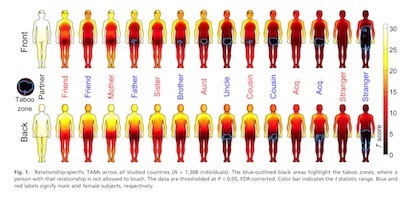
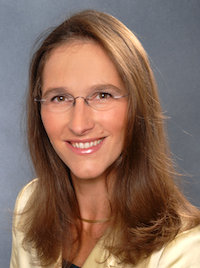 Human-milk-smell perfume, for the benefit of babies. (“Infant Formulation Containing an Aroma Composition For Use As Fragrance,” US patent 9167838B2, Andrea Buttner [pictured here], granted October 17, 2015. Featuring dramatic readings by Melissa Franklin.)
Human-milk-smell perfume, for the benefit of babies. (“Infant Formulation Containing an Aroma Composition For Use As Fragrance,” US patent 9167838B2, Andrea Buttner [pictured here], granted October 17, 2015. Featuring dramatic readings by Melissa Franklin.)The mysterious John Schedler or the shadowy Bruce Petschek perhaps did the sound engineering this week.
The Improbable Research podcast is all about research that makes people LAUGH, then THINK — real research, about anything and everything, from everywhere —research that may be good or bad, important or trivial, valuable or worthless. CBS distributes it, on the CBS Play.it web site, and on iTunes and Spotify).

November 24, 2015
Patent application of the day: six God toilet water itching
Today’s Patent Application of the Day is:
“Packaging labels (six God toilet water itching)“, Chinese patent application CN301200531 S, filed August 7, 2009.
BONUS: The runner-up: “God Forms’ Genres“, US patent application US20110240755 A1, filed May 16, 2011.
BONUS: A successful patent: “God First Flag“, US patent USD659588 S1, filed December 5, 2008. The patent document provides this image:

November 23, 2015
Ig Nobel Prize winner ponders and muses on how to win one
Len Fisher, who won an Ig Nobel physics prize in 1999, for calculating the optimal way to dunk a biscuit, wrote an essay about what wins people an Ig. That essay begins more or less:
…I suggested that the use of blue light to stimulate erections was a sure-fire candidate for an Ig Nobel Prize. But what is an Ig Nobel Prize? How does one go about winning one? And should one want to win one?
When they were initiated in 1991 as a parody of the real Nobel Prizes, the answer to the last question was “certainly not!” When Marc Abrahams from Harvard University created the prizes, part of his intention was to vilify pseudoscience and unscientific thinking, and the motto was “for research that cannot or should not be reproduced.”
But this was not the only intention, although many people interpreted it in that way. According to Marc: “That original phrase was the best short summary we managed to come up with at the beginning, but we were not entirely happy with it — because some people interpreted it ONLY [in that] the way … . Whenever I would TALK with someone, or had a more extensive email (or whatever) exchange, I’d explain that the “Cannot be reproduced” part included “cannot be the FIRST to LEGITIMATELY claim FIRSTNESS,” and thus the prizes could honor pretty much anything, good or bad.
But it took about seven frustrating years or so to come up with a reliably better phrase.…
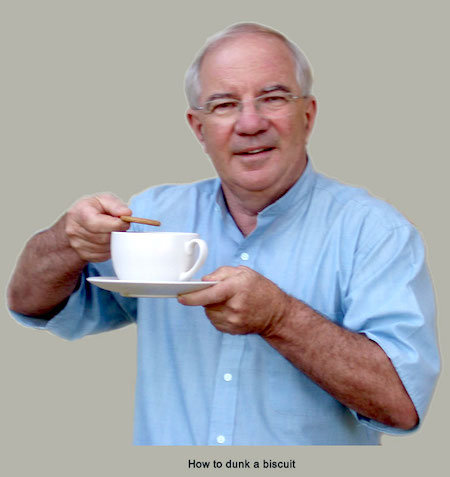

Driving trucks at birds – what happens?
Q. What happens if you drive a partially camouflaged Ford F-250 truck (travelling at 60 km/h [≈ 37 mph]) towards a group of feeding turkey vultures?
A. They get out of the way [pdq].
 This was one of the findings of an experimental study by Travis L. DeVault, Bradley F. Blackwell, Thomas W. Seamans, Steven L. Lima, and Esteban Fernández-Juricic, performed at NASA’s Plum Brook Station, Lake Erie, Ohio, US, in 2011. The team also drove the truck at 90 km/h [≈ 56 mph] and the vultures still got out of the way – but only just.
This was one of the findings of an experimental study by Travis L. DeVault, Bradley F. Blackwell, Thomas W. Seamans, Steven L. Lima, and Esteban Fernández-Juricic, performed at NASA’s Plum Brook Station, Lake Erie, Ohio, US, in 2011. The team also drove the truck at 90 km/h [≈ 56 mph] and the vultures still got out of the way – but only just.
Please note that no vultures were actually hit during any of the experiments. See: Effects of Vehicle Speed on Flight Initiation by Turkey Vultures: Implications for Bird-Vehicle Collisions, PLoS ONE 9(2): e87944
The following year, another, perhaps less ornithologically perilous experimental approach was taken by the same team. This time using male brown-headed cowbirds and with vehicles travelling up to a punishing 180 km/h [≈ 112 mph]. At these high speeds, the birds didn’t manage to get out of the way in time. But nevertheless none was injured – because in this experiment the vehicles were virtual rather than real. The birds were watching a video of an approaching truck instead of the truck itself. See: Speed kills : ineffective avian escape responses to oncoming vehicles. Proceedings of the Royal Society B 282(1801): 20142188. 2014
Also don’t miss ‘European birds adjust their flight initiation distance to road speed limits’ Biology Letters, October 23, 2013
BONUS (from NASA) ‘Bye Bye, Birdies’ especially vultures.

November 22, 2015
The further adventures of…. Dr. Chance
 “Dr. Chance and his research team discovered the details...” That thrilling, almost poetic passage is from a press release issued by Case Western Reserve University.
“Dr. Chance and his research team discovered the details...” That thrilling, almost poetic passage is from a press release issued by Case Western Reserve University.

November 21, 2015
The naturally agglomerated state
Some particle analyzers do not include a free fall model, a non-inclusion that can be frustrating for individuals of a certain temperament when they wish to analyze samples in their naturally agglomerated state. Investigator Pam Razin writes to inform us the the Cilas model #118o does not suffer from this deficiency. Its manufacturer explicitly states:
The 1180 includes a free fall module for customers wishing to analyze samples in their naturally agglomerated state.
Razin supplies no corresponding data — that is, he supplies a non-agglomeration of data — as regards other models and makes of particle-size analyzers.

Marc Abrahams's Blog
- Marc Abrahams's profile
- 14 followers




